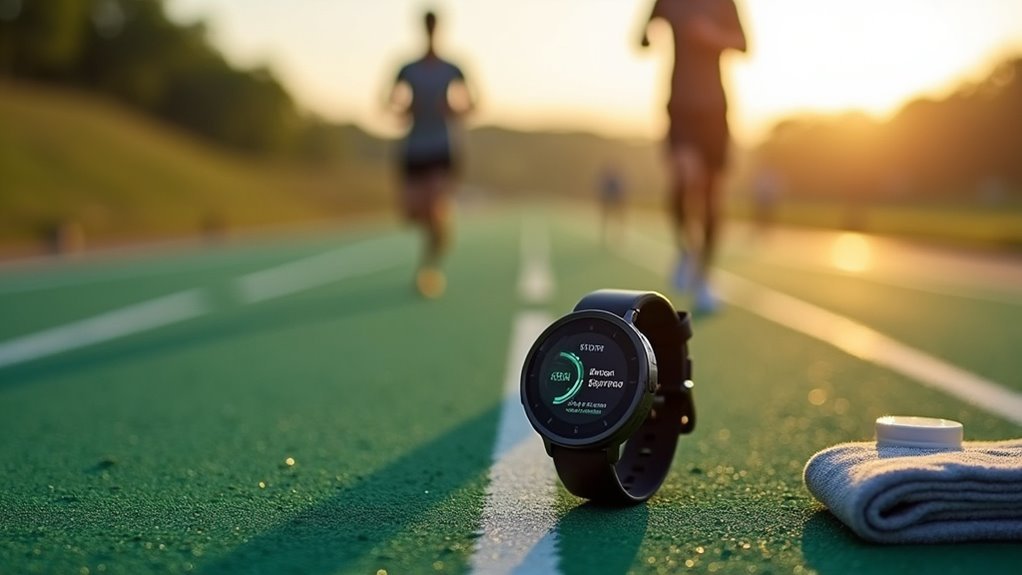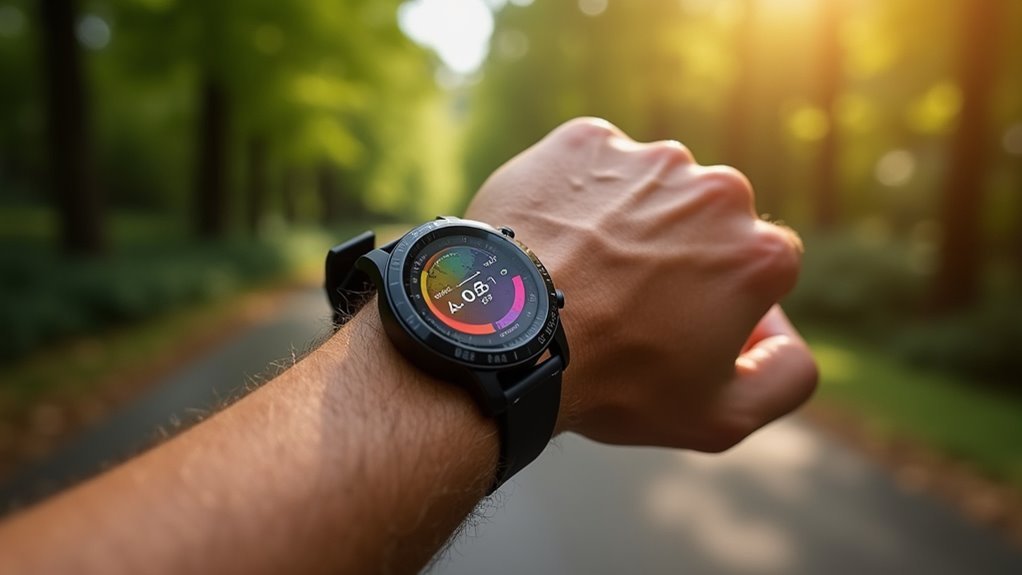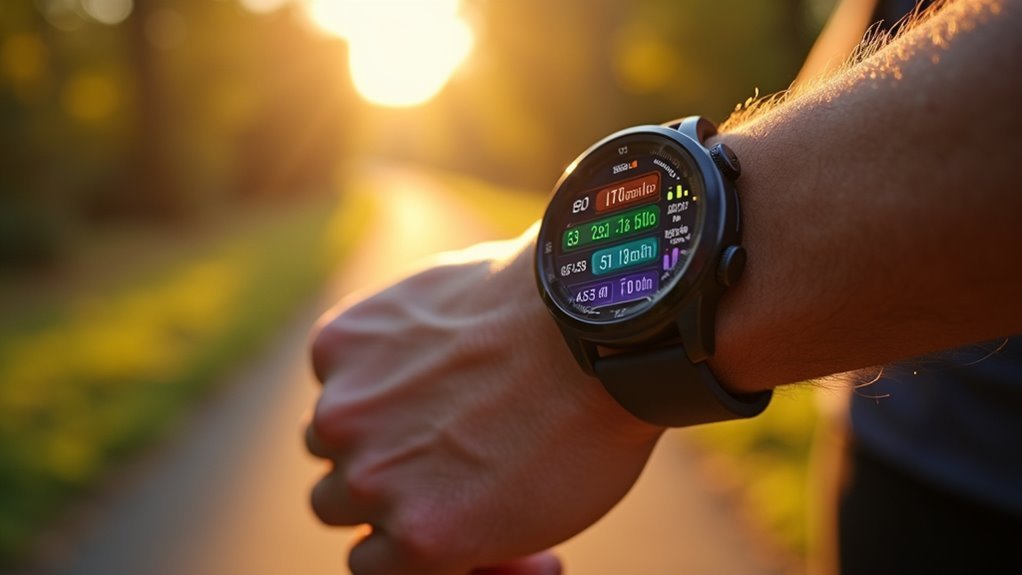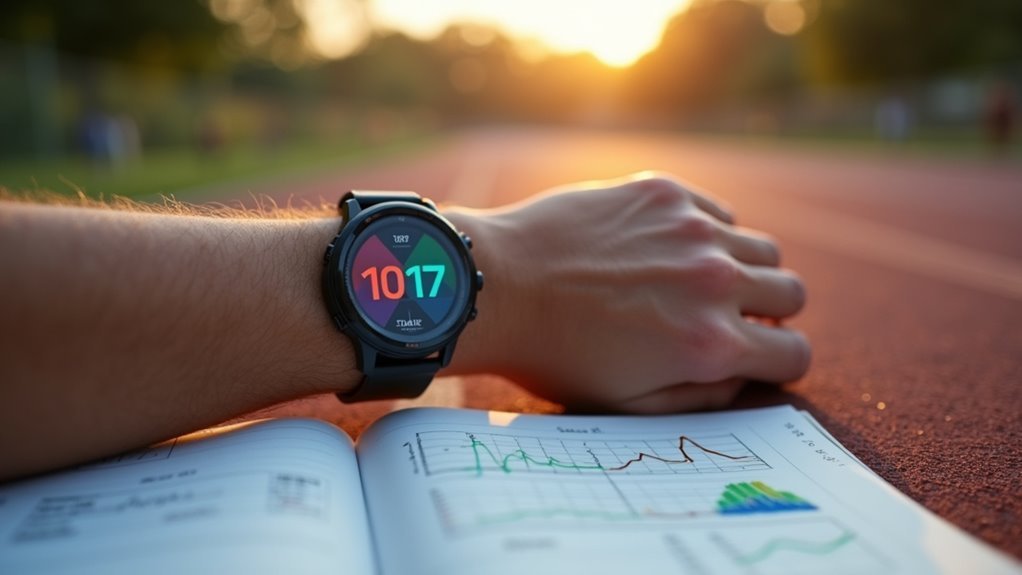You’ll get the most accurate lactate threshold readings by testing in consistent weather conditions on flat terrain at the same time of day. Master your device’s built-in protocol by selecting “outdoor running” and following on-screen prompts carefully. Position your smartwatch snugly one finger’s width above your wrist bone, ensuring clean skin contact. Validate results by comparing threshold velocities with your actual running performance at those intensities. Regular firmware updates and zone recalibration will keep your measurements precise and reliable for ideal training benefits ahead.
Choose Optimal Testing Conditions for Consistent Results

When tracking lactate threshold through your smartwatch, establishing ideal testing conditions forms the foundation for obtaining reliable and actionable data.
You’ll want to test in consistent weather conditions, avoiding extreme temperatures or humidity that can skew your performance. Choose flat terrain like running tracks to eliminate elevation variables that affect your effort levels.
Consistent environmental conditions and flat terrain are essential for accurate lactate threshold testing through your smartwatch.
Schedule tests at the same time of day to control for circadian rhythm impacts on your body’s performance. Guarantee good air quality and quiet environments to prevent respiratory issues and distractions that could compromise your focus.
Your physical state matters equally. Get adequate rest, maintain proper hydration and nutrition, and complete a thorough warm-up routine. Perform a warm-up jog before conducting any guided lactate threshold test to prepare your body for the assessment.
Avoid testing after intense training sessions, as fatigue will distort your threshold readings and compromise data accuracy.
Master Your Device’s Built-in LT Protocol
Once you’ve established ideal testing conditions, you’ll need to navigate your smartwatch’s built-in lactate threshold protocol to capture accurate data.
Start by selecting the appropriate activity type—typically “outdoor running”—then access your training options menu to locate the lactate threshold test feature.
Follow your device’s on-screen instructions precisely during the test. You’ll run specific intervals at target heart rates while your watch monitors constantly.
Pay attention to vibration signals that indicate when to shift between intervals or adjust your running intensity to match displayed targets.
After completing the test, you’ll have the option to accept or reject the calculated values. Remember that lactate threshold testing measures your body’s ability to clear lactate during exercise, with results showing your maximum running speed at specific heart rate levels.
Accept the results to automatically update your personalized heart rate zones, which you can then use to optimize future training sessions.
Ensure Proper Sensor Contact and Device Positioning

Accurate lactate threshold readings depend heavily on proper sensor contact and strategic device positioning throughout your testing session. Position your smartwatch at least one finger’s width above your wrist bone to avoid tendon interference. Confirm the band’s snug but not constricting, and clean your skin of lotions or oils beforehand.
| Setup Factor | Best Practice |
|---|---|
| Wrist Position | One finger’s width above wrist bone |
| Band Tightness | Snug but not constricting blood flow |
| Skin Preparation | Clean, dry, free of lotions/oils |
| Environmental Conditions | Stable outdoor space, moderate temperature |
Cold temperatures reduce blood flow and affect accuracy, so keep your skin warm. Monitor your device for poor contact warnings during exercise and adjust immediately. Double-check your setup before starting and readjust after warm-up when your arm size may change. Remember that a chest strap monitor provides the most reliable heart rate data for lactate threshold detection compared to wrist-based sensors alone.
Validate Results With Field Performance Metrics
While smartwatch technology continues advancing, you’ll need to cross-reference your device’s lactate threshold readings with established field performance metrics to guarantee accuracy.
Compare your smartwatch’s lactate threshold heart rate against traditional blood lactate samples during graded exercise tests. Run treadmill or outdoor protocols that generate actual lactate profiles, then check alignment with your device’s metrics.
Validate threshold velocities by cross-referencing your smartwatch data with field-tested running speeds at known physiological cutoff points like 4 mmol/L lactate concentration.
Use statistical analysis including Bland-Altman plots and correlation coefficients to assess agreement between devices. For optimal accuracy assessment, maintain MAPE below 10% when evaluating your device’s performance against laboratory standards.
Incorporate multi-parameter validation by combining heart rate data with muscle oxygenation measurements and perceived exertion ratings during standardized field tests for thorough accuracy verification.
Update Firmware and Recalibrate Training Zones Regularly

Because smartwatch manufacturers continuously refine their lactate threshold algorithms through firmware releases, you’ll need to update your device regularly to access the most accurate measurement capabilities.
These updates often enhance optical heart rate sensor algorithms and introduce automatic threshold estimation using heart rate, pace, and GPS data.
After installing firmware updates, you must recalibrate your training zones since new calculation methods can markedly alter your threshold measurements. Some users have reported 5 bpm increases in their lactate threshold values following algorithm updates.
Don’t ignore this step—misaligned zones can lead to overtraining or insufficient workout intensity. If automatic estimates seem inconsistent, manually enter your lactate threshold heart rate instead.
Expect some variability in readings immediately following updates as algorithms adjust.
Regular firmware maintenance guarantees you’re leveraging the latest sensor improvements for reliable metabolic threshold tracking.
Frequently Asked Questions
How Often Should I Perform Lactate Threshold Tests on My Smartwatch?
You should perform lactate threshold tests every 6-8 weeks for ideal training adjustments. If you’re a serious athlete, consider seasonal testing to align with changing goals and training cycles.
Can I Use My Smartwatch’s LT Data for Race Pacing Strategies?
Yes, you can use your smartwatch’s LT data to create effective race pacing strategies. It’ll help you maintain sustainable effort levels and avoid going out too hard early.
What’s the Difference Between Lactate Threshold and Anaerobic Threshold on Smartwatches?
You’ll find smartwatches often use these terms interchangeably or report a single threshold. Lactate threshold represents when lactate accumulates, while anaerobic threshold may indicate slightly higher intensity with rapid changes.
Do Medications or Caffeine Affect Smartwatch Lactate Threshold Accuracy?
Yes, medications like beta-blockers can lower your heart rate responses, while caffeine elevates it independently of exercise intensity. Both skew smartwatch algorithms that rely on heart rate data, potentially causing inaccurate lactate threshold readings.
Can I Track Lactate Threshold Improvements for Sports Other Than Running?
You can track lactate threshold improvements for cycling and swimming, but smartwatch accuracy varies considerably. Most devices work best for running. Consider lab testing or field tests with power meters for more reliable sport-specific data.
In Summary
You’ll maximize your lactate threshold tracking accuracy by following these five essential steps. Don’t underestimate the impact of consistent testing conditions and proper device positioning—they’re game-changers for reliable data. Remember to cross-reference your smartwatch readings with real-world performance to validate results. Keep your firmware updated and recalibrate zones regularly to maintain precision. With these practices, you’ll transform your smartwatch into a powerful training tool that delivers actionable insights for performance improvement.





Leave a Reply